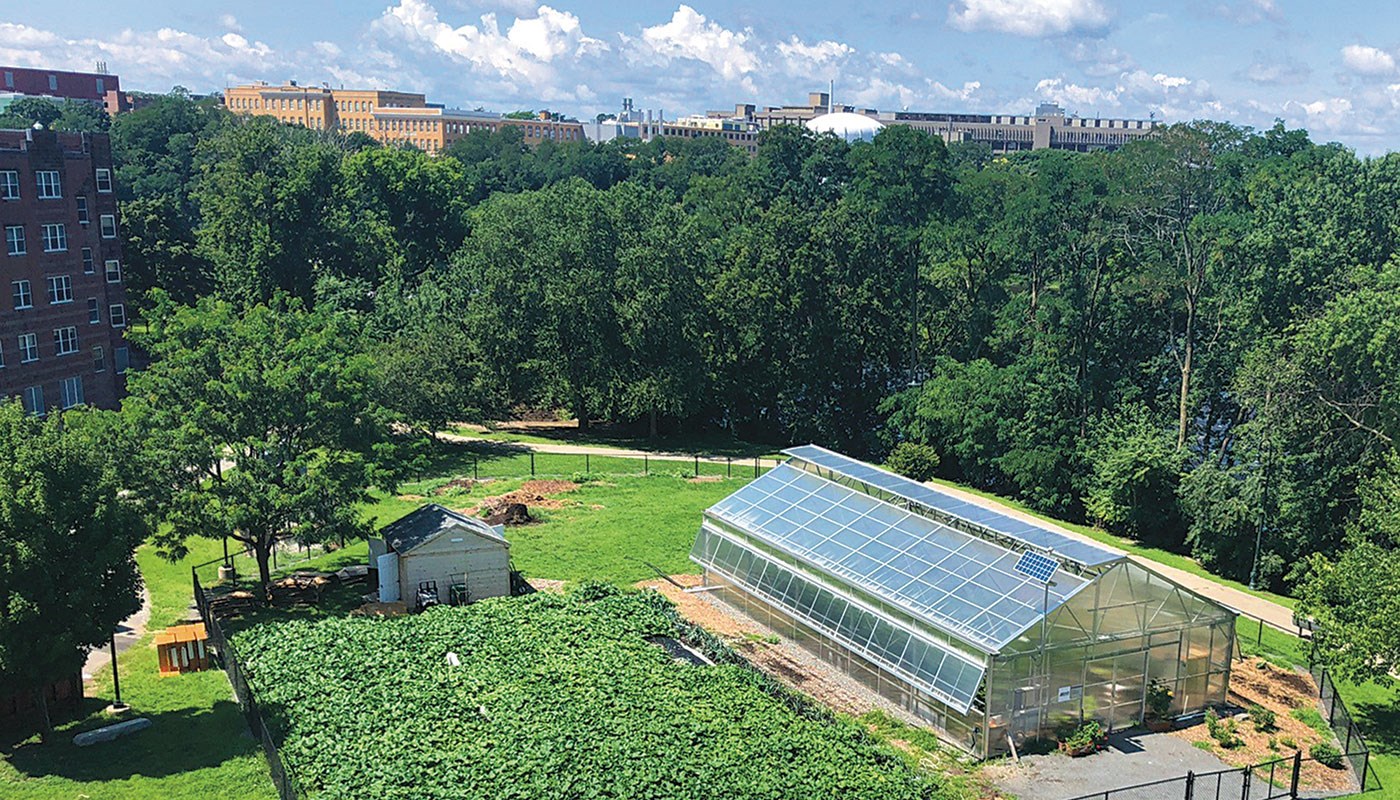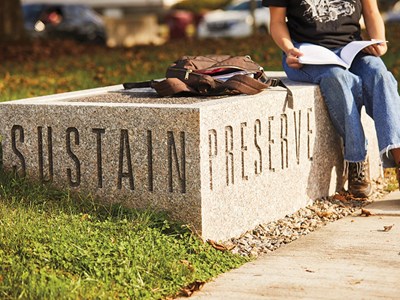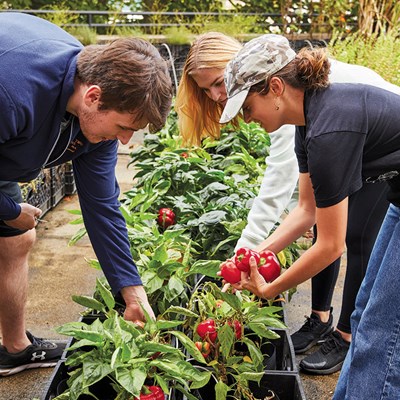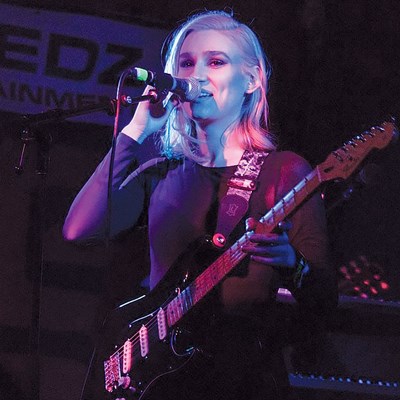How UMass Lowell became the top-ranked school in Massachusetts for sustainability, and what it’s doing to help solve the climate crisis
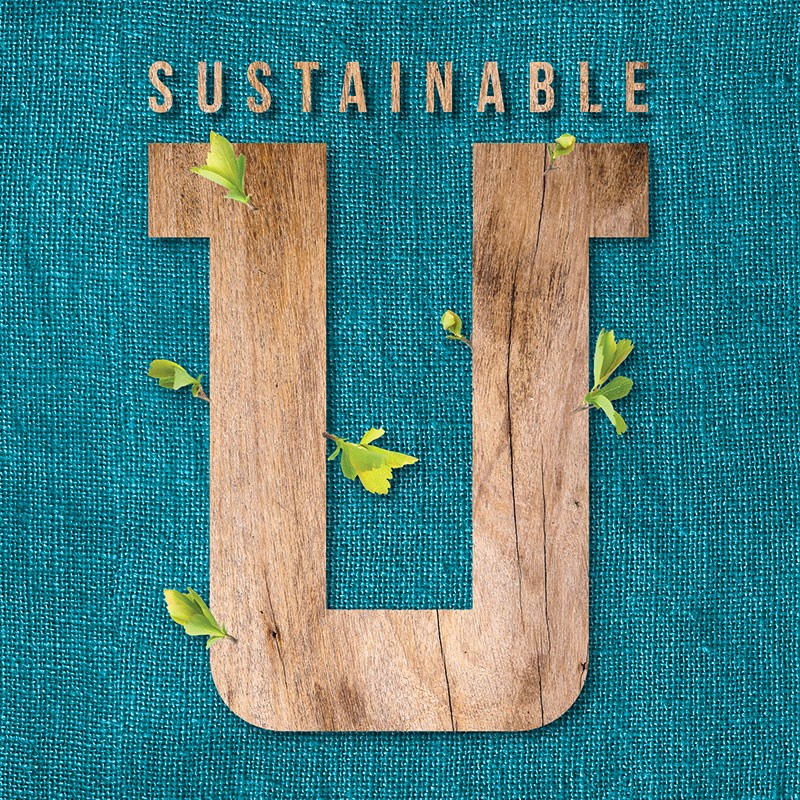
03/01/2022
By Ed Brennen
On move-in weekend this fall, Martha Hernandez found herself roaming the hallways of University Suites on East Campus. The senior public health major from Lawrence, Massachusetts, was checking recycle bins for cardboard and Styrofoam — the discarded materials that tend to pile up when students unpack their desk lamps, hair dryers, TVs and other dorm essentials.
Hernandez was there with a half dozen other student employees from UMass Lowell’s Office of Sustainability. Officially known as sustainability resource ambassadors, their job was to keep recyclable materials from ending up in landfills. But they also served another purpose: to informally introduce students to UML’s sustainability efforts.
Welcome to Sustainable U.
“I’ve always been concerned about the environment,” says Hernandez, who decided to join the Office of Sustainability this year after witnessing yet another summer of catastrophic climate disasters: record-setting heat waves in the Pacific Northwest that killed nearly 1,000 people; raging wildfires out west that sent smoke all the way to Lowell; and powerful hurricanes that triggered deadly flooding in New York, New Jersey, Pennsylvania and Connecticut.
“Seeing what’s happening in the world right now with the climate crisis and the effects it’s having, especially on low-income communities and developing countries, motivates me to try to make a change,” Hernandez says. “I know that I’m just one person, but it takes the effort of one to influence others.”
As a card-carrying member of Gen Z, her concern for the environment and passion for sustainability are not surprising.
“This current generation of students seems to have their heads on a lot straighter than older generations do in terms of understanding the importance of these problems,” says Juliette Rooney-Varga, professor of environmental, earth and atmospheric sciences (EEAS) in the Kennedy College of Sciences and director of UML’s Climate Change Initiative (CCI), a research center that addresses climate change through academic programs and community outreach.
Launched in 2010, the CCI has played a key role in the university’s emergence as a national leader in sustainability over the past decade. Since pledging to achieve climate neutrality by 2050 by signing on to the American College and University Presidents’ Climate Commitment in 2007, UML has, among other things, implemented a zero-sort recycling program, adopted a Climate Action Plan, established the Office of Sustainability and launched an Urban Agriculture Program.
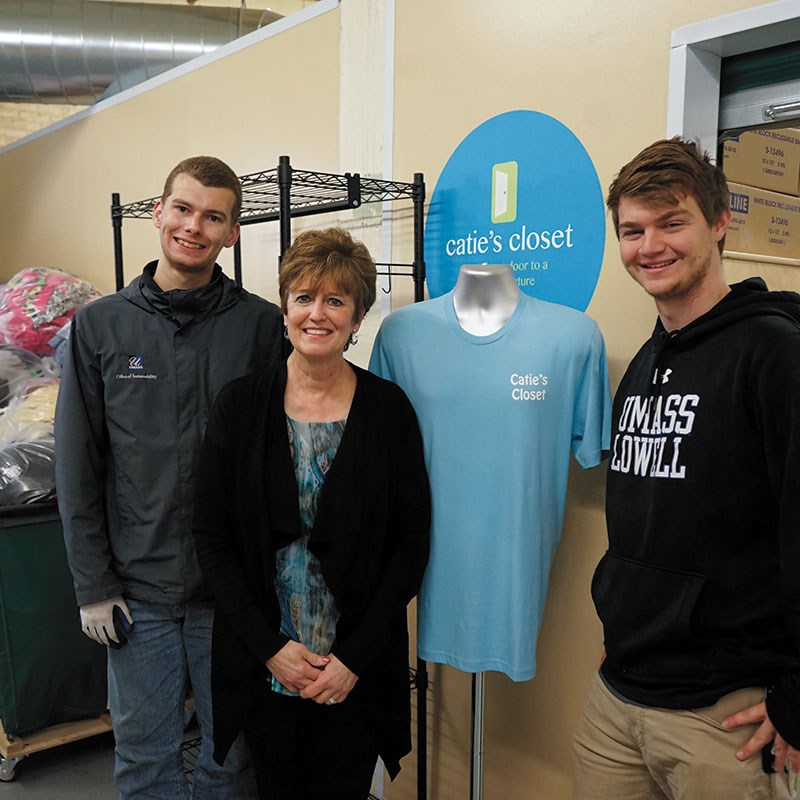
“I’m proud of the work we’ve done at UMass Lowell to become the No. 1 green campus in Massachusetts,” says Chancellor Jacquie Moloney, who took the sustainability baton from her predecessor, Marty Meehan, in 2015 and ran with it.
Consider: UML has received $37.5 million in climate change-related research funding since 2019, added degree programs around climate change, sustainability and environmental science, and established more than 140 community and corporate sustainability partnerships. And with the completion in 2019 of the $23.1 million Accelerated Energy Program, a three-year initiative designed to make the campus more energy-efficient, UML has reduced its annual carbon footprint by nearly 9 million pounds of carbon dioxide emissions and slashed energy costs by roughly $1.2 million a year.
“Our efforts have reduced our impact on the environment and saved millions of operating dollars,” says Moloney, who will pass on the baton to a new chancellor next summer. “We’ve made great progress, but we know there’s still work to do.”
That work now falls under the purview of the Rist Institute for Sustainability and Energy (RISE). Founded in 2019 through a $1 million gift from philanthropists Brian ’77 and Kim Rist, the institute fuses the efforts of the CCI and Office of Sustainability with UML’s energy innovation research.
“We are a lot more together than the sum of our parts,” says Rooney-Varga, who leads the institute with Director of Sustainability Ruairi O’Mahony and Mechanical Engineering Prof. Christopher Niezrecki, director of UML’s Center for Wind Energy. “By bringing these different components together, we can drive new innovation that leads to evidence-based action.”
“The campus is a living lab,” adds O’Mahony. “The institute allows us to create blueprints for sustainability for others to follow, while also providing opportunities in teaching, research and community engagement.”
‘RISE’ to the Challenge
Rist, a business alumnus originally from Stoughton, Massachusetts, made his fortune by helping people withstand hurricanes — one of the natural disasters that climate science shows is increasing in intensity due to warmer global temperatures. After experiencing the damaging effects of Hurricane Andrew in 1992, Rist founded Storm Smart, the country’s largest manufacturer and installer of hurricane protection systems. He sold the Florida-based company last year and created the Rist Family Foundation so he and his wife could focus on their charitable endeavors.
“The culture of the university lends itself to taking on some of these challenges. It’s more of a bootstrap approach, which is what I really love about the university.” -Brian Rist ’77“We’ve always had a passion for sustainability, so when the university came to us, it was a fairly easy decision. If we don’t do a better job taking care of the world we live in, we’re really going to have some problems,” says Rist, whose $1 million contribution was part of a larger $5 million donation to the university (he and his wife also support the Rist DifferenceMaker Institute).
Rist gets periodic email updates from O’Mahony on how the money is being used — the completion of UML’s first-ever Alternative Energy Master Plan; a new rooftop farm planted at O’Leary Library last summer; the latest student and faculty recipients of RISE Fellowships—and is consistently amazed, though not totally surprised, by what what’s being accomplished at his alma mater.
“The culture of the university lends itself to taking on some of these challenges. It’s more of a bootstrap approach, which is what I really love about the university,” he says. “It’s not a lot of silver spoons and easy sailing; it’s roll up your sleeves and get things done. Ruairi and his team get their hands dirty. Sometimes they might be talking to the governor, sometimes they’re digging holes. That’s really what makes it work—and what makes it so exciting for us.”
One place where students get their hands dirty is at the Rist Urban Agriculture Farm behind Donahue Hall on East Campus. On a gray Thursday morning in late September, Rooney-Varga brought her “Climate Change: Science, Communication, Solutions'' class there for a field trip. O’Mahony told students about some of the earth-friendly gardening techniques used at the greenhouse (such as food waste from dining halls being composted for fertilizer) and how, thanks to a partnership with the urban farming nonprofit Mill City Grows, the crops help address food insecurity in Lowell.
“So much of what we’re doing in terms of the university’s Climate Action Plan is invisible, so it’s nice having students see, hear, feel and smell some of the little pieces we’re doing,” Rooney-Varga says.
Perhaps nothing is more invisible than the work going on behind the scenes to make the 54 buildings across campus more energy efficient. According to Energy Manager Dan Abrahamson, more than half of the university’s greenhouse gas emissions come from heating and cooling classrooms, labs, residence halls and offices. If UML is to achieve carbon neutrality in the next 30 years, that must change. So the university recently completed its Alternative Energy Master Plan, funded by a $100,000 grant from the Massachusetts Department of Energy Resources, to identify and prioritize campus projects that can help meet future energy demands while also cutting emissions.
“We went through the entire campus with a fine-tooth comb looking for energy-efficiency opportunities in each building,” says O’Mahony, who notes that lowering the university’s overall energy load now will make it easier to one day replace its two existing steam plants, which run on oil and natural gas, with more climate-friendly alternatives.
“A lot of work’s been done — with the Accelerated Energy Program and some renewable energy installations — but we need a more forward-looking approach,” O’Mahony says. “It’s an enormous scope of work for us, but there’s no point in putting our heads in the sand and saying, ‘Stick solar panels on everything,’ because that’s not going to get us there.”
As Rooney-Varga puts it, “The cleanest energy is the energy we don’t use.”
An Interdisciplinary Approach
On Aug. 9, amid all the devastating heat waves, fires and flooding, the United Nations’ Intergovernmental Panel on Climate Change released its latest international climate assessment report. Described as a “code red for humanity” by U.N. Secretary General António Guterres, the 3,000-page report — based on the assessment of over 14,000 scientific publications — made clear that human-induced climate change is real and that dramatic reductions in greenhouse gas emissions are needed immediately to avert even worse catastrophe.
Among the 234 scientists from 66 countries who prepared the report was EEAS Prof. Mathew Barlow, who co-authored the chapter on changes to the water cycle. Barlow and his colleagues warned that the water cycle — the processes of evaporation, condensation and precipitation that kids learn about in grade school — has been intensifying and that both wet and dry extremes will continue to increase with future global warming.
“Until we start reducing emissions, we’re going to keep seeing unprecedented events year after year,” he says.
Indeed, just weeks after the U.N. report came out, the remnants of Hurricane Ida dumped a record 3.15 inches of rain on New York’s Central Park in a one-hour span, forcing the National Weather Service to issue the city’s first-ever flash flood warning. A dozen New Yorkers drowned in their basement apartments.
“Even for those of us who know that’s what we’d expect to see on a scientific level, it’s still shocking to see people being flooded in their apartments,” Barlow says.
According to the U.S. National Oceanic and Atmospheric Administration, the 10 warmest years for global average temperatures all have occurred since 2005, and seven of them have occurred since 2014. Boston experienced its hottest summer on record this year, with the third highest rainfall total.
While he doesn’t like the phrase “climate anxiety,” Barlow admits that “it can be kind of overwhelming when this is what you look at all day.” He takes some personal comfort in the fact that he works at a university where researchers are taking on the problem from every angle — particularly as a member of the CCI, which draws on faculty not just from the hard sciences, but also fields such as art, history, nursing and business.
“It’s really satisfying to feel like there’s a community with the broad expertise needed to address the problem, because it’s a problem that needs that scope of efforts,” says Barlow, who recently completed research on climate change’s link to the cold snap in Texas last winter that killed more than 200 people.
Niezrecki, who researches renewable energy systems and wind turbine dynamics, says it will take a collective effort to avert the projected 4°C (7.2°F) rise in global temperature by century’s end.
“If we go up 3 or 4 degrees, we’re talking potentially billions of people being impacted by the effects of global warming: heat wave exposure, water stress, risks to power production and crop yield, habitat degradation,” says Niezrecki, who addressed the topic during his Distinguished University Professor lecture last spring. “It’s a little hard to conceptualize that now and fast-forward decades in advance, but the science is pretty clear about this.”
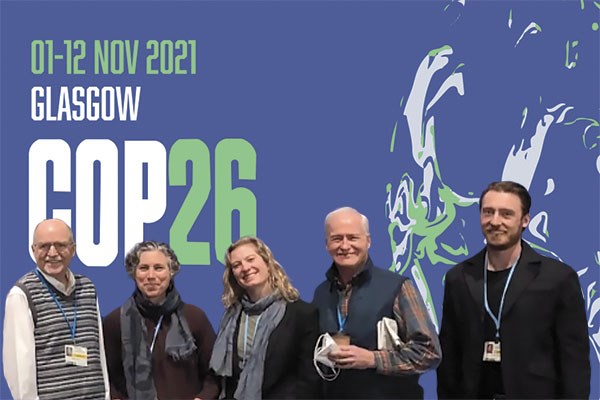
“It’s an opportunity to share our work, network and report back to the broader community on what is happening there,” says Rooney-Varga, who expects UML students will have an opportunity to participate in future COP conferences.
Six years ago, Rooney-Varga took part in COP21, which resulted in the Paris Agreement, the landmark accord that aims to keep global temperatures from rising more than 2°C (3.6°F) by 2100. Since then, she’s noticed an increasing number of countries, businesses and institutions claiming to have net-zero carbon goals — although not much action to back up the talk.
“I used to be incredibly excited when I heard somebody say they wanted their institution or country to be net-zero by fill-in-the-blank date. It’s becoming very easy to just say that and then not back it up with science-based action,” she says. “How are you implementing that goal and how are you fact-checking it to make sure that it’s real and that it’s not about gaming a carbon-offsetting system?”
Thankfully, she says, UML’s Climate Action Plan to achieve net-zero emissions by 2050 is supported by legitimate action at every level of the university.
“We’re actually taking steps now to ensure that we do achieve science-based carbon neutrality by 2050, and I think that’s worth a lot,” she says. “It’s not just talk.”
And after a decade of considerable progress here on campus, UMass Lowell is spreading the word to the rest of the world.
“Is there hope? I like to think so,” Niezrecki says. “I think we’re on the right trajectory of doing the things we need to do.”

